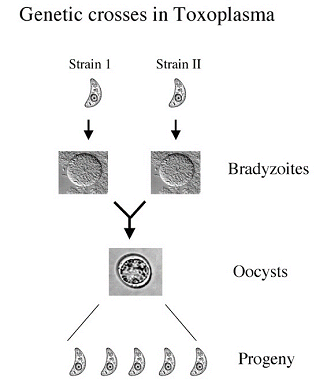

|
|
Experimental Genetics
|
Dr. Elmer Pfefferkorn, Dartmouth University, established the basic principles of genetic mapping in T. gondii. Drug resistance markers were generated in two strains of T. gondii that were adapted to use in the laboratory. Fortuitously, these strains included the type II and III lineages: clone PLK was derived from the type II Me49 strain, originally isolated from a sheep in California; and CEP, a type III strain solated from a cat in Dartmouth, NH. Dr. Pfefferkron’s studies established here is no predetermined mating type, but rather a single organism can complete the entire life cycle (Pfefferkorn et al. 1977). Consequently, when two strains infect a cat simultaneously, they can undergo self-mating or outcross to generate recombinant progeny. Inheritance |
|
|
follows simple Mendelian rules of inheritance and the ratios of progeny obtained help confirm the haploid nature of the replicating stages (Pfefferkorn and Pfefferkorn 1980). Some of the advantages of classical genetics in T. gondii include: a relatively stable genome allows simple linkage analysis, a single cross can generate thousands of distinct progeny, haploidy simplifies genetic typing, and allows direct observation of phenotypes, progeny can be cryo-preserved and analyzed at a later date. Two primary experimental crosses have been used in the generation of linkage maps for T. gondii.
|
||
Department of Molecular Microbiology
Washington University School of Medicine
St. Louis, MO USA

